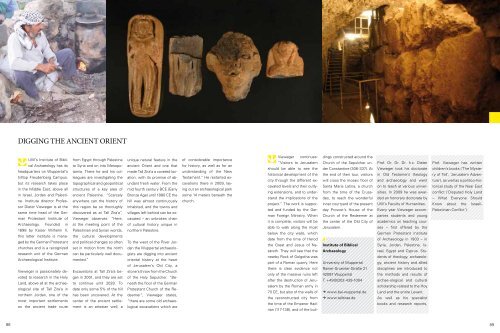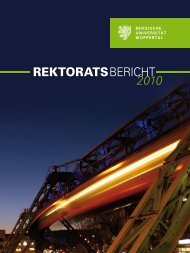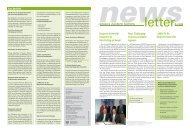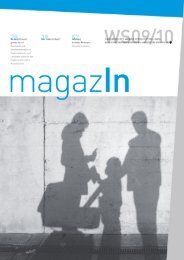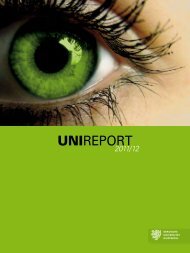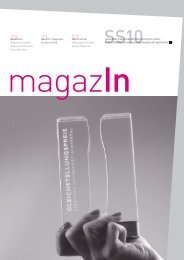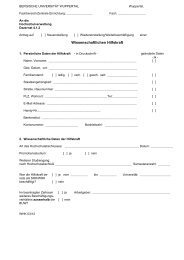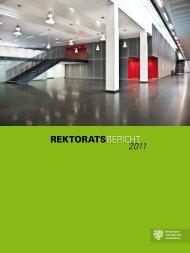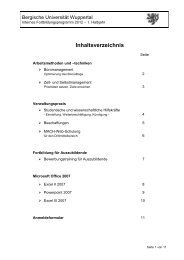international - Bergische Universität Wuppertal
international - Bergische Universität Wuppertal
international - Bergische Universität Wuppertal
You also want an ePaper? Increase the reach of your titles
YUMPU automatically turns print PDFs into web optimized ePapers that Google loves.
88<br />
Digging the anCient orient<br />
UW’s Institute of Bibli-<br />
cal Archaeology has its<br />
headquarters on <strong>Wuppertal</strong>’s<br />
hilltop Freudenberg Campus,<br />
but its research takes place<br />
in the Middle East, above all<br />
in Israel, Jordan and Palestine.<br />
Institute director Professor<br />
Dieter Vieweger is at the<br />
same time head of the German<br />
Protestant Institute of<br />
Archaeology. Founded in<br />
1898 by Kaiser Wilhelm II,<br />
this latter institute is managed<br />
by the German Protestant<br />
churches and is a recognized<br />
research unit of the German<br />
Archaeological Institute.<br />
Vieweger is passionately de-<br />
voted to research in the Holy<br />
Land, above all at the archaeological<br />
site of Tall Zira’a in<br />
northern Jordan, one of the<br />
most important settlements<br />
on the ancient trade route<br />
from Egypt through Palestine<br />
to Syria and on into Mesopotamia.<br />
There he and his colleagues<br />
are investigating the<br />
topographical and geopolitical<br />
structures of a key area of<br />
ancient Palestine. “Scarcely<br />
anywhere can the history of<br />
this region be so thoroughly<br />
discovered as at Tall Zira’a”,<br />
Vieweger observes. “Here,<br />
at the meeting point of the<br />
Palestinian and Syrian worlds,<br />
the cultural developments<br />
and political changes so often<br />
set in motion from the north<br />
can be particularly well documented.”<br />
Excavations at Tall Zira’a be-<br />
gan in 2001, and they are set<br />
to continue until 2028. To<br />
date only some 5% of the hill<br />
has been uncovered. At the<br />
center of the ancient settlement<br />
is an artesian well, a<br />
unique natural feature in the<br />
ancient orient and one that<br />
made Tall Zira’a a coveted location,<br />
with its promise of abundant<br />
fresh water. From the<br />
mid fourth century BCE (Early<br />
Bronze Age) until 1880 CE the<br />
hill was almost continuously<br />
inhabited, and the towns and<br />
villages left behind can be excavated<br />
– an unbroken chain<br />
of cultural history unique in<br />
northern Palestine.<br />
To the west of the River Jor-<br />
dan the <strong>Wuppertal</strong> archaeolo-<br />
gists are digging into ancient<br />
oriental history at the heart<br />
of Jerusalem’s old City, a<br />
stone’s throw from the Church<br />
of the Holy Sepulcher. “Beneath<br />
the floor of the German<br />
Protestant Church of the Redeemer”,<br />
Vieweger states,<br />
“there are some old archaeological<br />
excavations which are<br />
of considerable importance<br />
for history, as well as for an<br />
understanding of the New<br />
Testament.” He restarted excavations<br />
there in 2009, laying<br />
out an archaeological park<br />
some 14 meters beneath the<br />
church.<br />
Vieweger continues:<br />
“Visitors to Jerusalem<br />
should be able to see the<br />
historical development of the<br />
city through the different excavated<br />
levels and their outlying<br />
extensions, and to understand<br />
the implications of the<br />
project.” The work is supported<br />
and funded by the German<br />
Foreign Ministry. When<br />
it is complete, visitors will be<br />
able to walk along the moat<br />
below the city walls, which<br />
date from the time of Herod<br />
the Great and Jesus of Nazareth.<br />
They will see that the<br />
nearby Rock of Golgotha was<br />
part of a Roman quarry. Here<br />
there is clear evidence not<br />
only of the massive ruins left<br />
after the destruction of Jerusalem<br />
by the Roman army in<br />
70 CE, but also of the walls of<br />
the reconstructed city from<br />
the time of the Emperor Hadrian<br />
(117-138), and of the buil-<br />
dings constructed around the<br />
Church of the Sepulcher under<br />
Constantine (306-337). At<br />
the end of their tour, visitors<br />
will cross the mosaic floor of<br />
Santa Maria Latina, a church<br />
from the time of the Crusades,<br />
to reach the wonderful<br />
inner courtyard of the present<br />
day Provost’s House of the<br />
Church of the Redeemer at<br />
the center of the old City of<br />
Jerusalem.<br />
institute of biblical<br />
Archaeology<br />
University of <strong>Wuppertal</strong><br />
Rainer-Gruenter-Straße 21<br />
42097 <strong>Wuppertal</strong><br />
T: +49(0)202-439-1004<br />
k www.bai-wuppertal.de<br />
k www.tallziraa.de<br />
Prof. Dr. Dr. Dr. h.c. Dieter<br />
Vieweger took his doctorate<br />
in old Testament theology<br />
and archaeology and went<br />
on to teach at various universities.<br />
In 2009 he was awarded<br />
an honorary doctorate by<br />
UW’s Faculty of Humanities.<br />
Every year Vieweger accompanies<br />
students and young<br />
academics on teaching courses<br />
– first offered by the<br />
German Protestant Institute<br />
of Archaeology in 1903 – in<br />
Syria, Jordan, Palestine, Israel,<br />
Egypt and Cyprus. Students<br />
of theology, archaeology,<br />
ancient history and allied<br />
disciplines are introduced to<br />
the methods and results of<br />
archae-ological and cultural<br />
scholarship related to the Hoy<br />
Land and the entire Levant.<br />
As well as his specialist<br />
books and research reports,<br />
Prof. Vieweger has written<br />
children’s books (‘The Mystery<br />
of Tell’, ‘Jerusalem Adventure’),<br />
as well as a politico-historical<br />
study of the Near East<br />
conflict (‘Disputed Holy Land<br />
– What Everyone Should<br />
Know about the Israeli-<br />
Palestinian Conflict’).<br />
89


